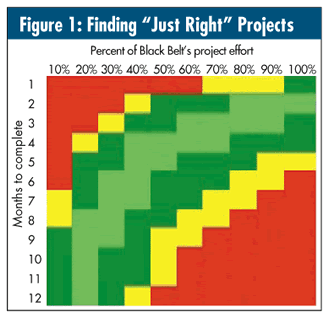Finding the Goldilocks Opportunity
Being a change agent is tough. In this column I'll discuss some guidelines that will help you succeed. I'll assume that you're part of my target audience if:
1. You work full time as a change agent or Six Sigma Black Belt.
2. You're looking for advice regarding projects.
3. Your organization is committed to change at the CEO level.
If your CEO is leading organizational change, you should have access to a portfolio of opportunities. These might not be well-defined projects but rather statements of ways to move closer to top management's vision for the organization. The statements will describe benefits for major stakeholders such as customers, employees or investors.
If no such list exists, work with your Six Sigma champion to create one. It's better to spend your time defining a big opportunity than to go after a ho-hum project just because it's there. Pick an opportunity that excites you. One of the most important factors leading to a successful project is the passion the change agent brings to it.
Sponsors are perhaps the most important personal link between the project team and the organization's leadership. Project sponsors play a critical role in helping the team overcome barriers to success. Choose your sponsor bearing this role in mind. Try to anticipate the barriers you'll face. Match the potential barriers to the organization chart to identify sponsor candidates.
Because good sponsors have important duties, their time is scarce. It's not enough to have sponsors commit to projects. You must get them to actually schedule time in advance. If you're not on their calendars, you don't have their full commitment.
Your project should create value for one of three groups: customers, employees or investors. To make the cut, a project should provide benefits that will have a substantial effect on the organization's success.
Your project might require that you use certain scarce resources. These could include people, information systems, data or money. List these resources and try to determine which of them will be difficult to obtain. Even one essential resource that's unavailable could be enough to torpedo your project. Use this information to help you choose a sponsor and your team.
A Black Belt is typically expected to put $1 million on the bottom line each year. This return on investment (ROI) may be from hard savings, increased profitability or an equivalent improvement in an employee metric such as reduced turnover, recruiting or training costs. The effort you put into a project must be compared to its potential benefits to ensure that it will meet the bottom-line goal.
 Find a Goldilocks project. Some projects are too small. Some are too big. Your goal should be to find a project that's "just right." Use the guide in figure 1, above, to help you find the sweet spot. The red spaces represent projects that are much too big or two small; yellow ones are a little too big or small; dark green is getting close; and light green is just right. Find a Goldilocks project. Some projects are too small. Some are too big. Your goal should be to find a project that's "just right." Use the guide in figure 1, above, to help you find the sweet spot. The red spaces represent projects that are much too big or two small; yellow ones are a little too big or small; dark green is getting close; and light green is just right.
Remember that a change agent doesn't make the change but facilitates it. The project team will do the lion's share of the work, so choose your team members carefully. Consider both their ability to help with the tasks and to work effectively in a team environment. Once you've identified willing team candidates, approach their supervisors (perhaps with your sponsor) and make sure that they can spend the necessary time on the project. If you're unable to find ready, willing and able persons for key roles, downgrade the project accordingly.
Project charter documents are your official authorization to proceed. Charters include the following key elements: problem statements, business case, deliverable descriptions, team membership and timelines. If any of these elements are incomplete or unclear, take action to correct them. If you're unable to do so, downgrade the project.
There are many excellent projects that don't require a Six Sigma skill set. As a change agent, you're specially trained in a project-execution framework (e.g., DMAIC, DFSS or lean) and a set of technical tools to help you link unknown causes to desired effects. These skills often aren't essential to a project's success. For example, an information systems project might involve deploying new technology using a proven approach. If the project can be done without your special skills, move on to some other opportunity.
Thomas Pyzdek, author of The Six Sigma Handbook (McGraw-Hill, 2003), provides consulting and training to clients worldwide. He holds more than 50 copyrights and has written hundreds of papers on process improvement. Visit him at www.pyzdek.com.
|